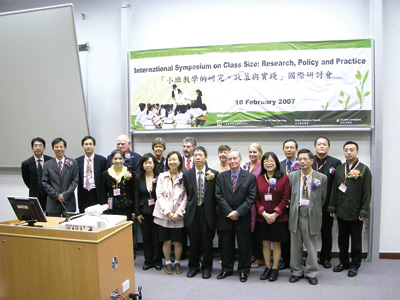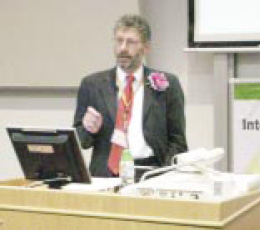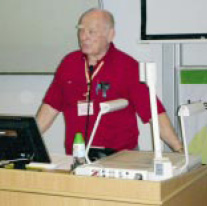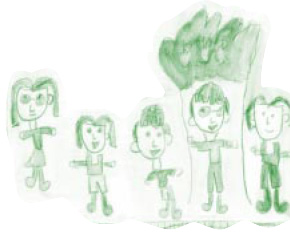
|
|
  |
| |
International Symposium on Class Size:
Research, Policy and Practice
In recent years, class size has become a hot topic among educators both worldwide and in the East Asia region. Under active promotion, small class teaching has been put into practice in many western countries and East Asian cities. Their experience is both considerable and valuable.
On 10 February 2007, an international symposium on "Class Size: Research, Policy and Practice" was jointly held by HKIEd's Centre for Development and Research in Small Class Teaching, the Gifted Education Council and Education Convergence. Academics and educators from ten countries and regions were invited to share their research results, policy plans and practical experience in small class teaching with more than 140 participants at the symposium.
|
UK |
 |
Professor Peter Blatchford of the University of London outlined the results of his extensive research on small class teaching. Using the multi-method approach, Prof Blatchford surveyed nearly 20,000 students from pre-school (4 - 5 years of age) to Grade 6 (11 years of age), with class sizes of 14 to 32. His research results indicate that pre-school students reap the greatest benefit from small class teaching, in terms of reading and mathematical ability.with class sizes of 14 to 32. His research results indicate that pre-school students reap the greatest benefit from small class teaching, in terms of reading and mathematical ability. Small class teaching has also proven to be of greatest help to students with the worst learning performances. Professor Blatchford was particularly interested in the changes in both teachers and students in a small class teaching environment - the teachers are more concerned with the performance of individual students, there is greater interaction between teachers and students, and teachers tend to spend longer hours on the job. Relatively speaking, other attempts to change the class environment, such as providing teaching assistants or setting up flexible learning groups, do not produce equally obvious results. The professional development of teachers is therefore vital to the successful implementation of small class teaching.
|
|
USA |
 |
The world renowned STAR (Student-Teacher Achievement Ratio) programme employs the "experimental design research" method. Professor Charles Achilles, the programme's principal researcher, stressed that student-teacher ratio and class size were two entirely different concepts. He pointed out that the earlier the studentsare exposed to small class teaching (with class sizes of between 13 and 17), the more profound the positive impact on them.
Tracking research has indicated that students who have been taught in small classes during their three years in kindergarten, perform better in their college entrance examinations than their counterparts from big classes. Additionally, the longer the students are taught in small classes, the more likely they are to complete high school. Research results also show that students who stay in small classes for a longer time in their junior grades achieve higher standards in the study of foreign languages and mathematics. According to Professor Achilles, research data from the STAR programme are open to all, and researchers from around the world are welcome to use the data to further their analysis on the effects of small class teaching. |
 |
|
ASIA |
|
Mr Ip Kin-yuen, Principal of HKICC Lee Shau Kee School of Creativity and Academic Consultant for the Centre for Development and Research in Small Class Teaching, pointed out that many people misinterpret the phenomenon that Asian students, largely trained in big classes, attain better academic results than their western counterparts mostly trained in small classes. In fact, according to Mr Ip, Asian students are often subject to uniformity and obedience at school. It is only their examination results that are comparatively high, not their motivation to learn. Coincidentally, many East Asian countries and regions have introduced education reforms from the 1990s, focusing on "creativity", "interaction" and "individualised education". Besides being catalytic to the development of creativity and interaction inside classrooms, small class teaching has also been an expedient to education reforms.
|

| |
Small Class Teaching in East Asia: An Overview |
| Singapore |
Singapore launched a nationwide policy in 2005: class sizes for Primary 1 and 2 have been reduced from 40 to 30 since then. |
| South Korea |
Average class sizes used to be over 60 in the 1960s. A "7.20 initiative for improving educational environment" was implemented in 2001. From 2005 onwards, class sizes were reduced to 31.8 in primary grades, 35.3 in junior secondary grades and 33.9 in senior secondary grades. |
| Taiwan |
Average class size used to be around 70 in the1980s. In May 1988, the Education Bureau launched a "Plan for Developing Small Classes" which set 35 as the standard class size for all public secondary and primary schools until end of the school year in 2007. |
| Macau |
Government subsidies in education were limited before Macau's handover to China. Traditionally, the Chinese community raised their own funds to run local schools with a class size varying from 50 to 90. Class sizes in recent years have been reduced to 35. |
| Shanghai |
The municipal government has promoted small class teaching since 1996. From an average of over 50, class sizes in Shanghai's primary schools have been reduced to around 20 to 24, and most of the primary schools in Shanghai's urban districts have completed their class size reduction process. |
| Hangzhou |
From 1998 until the present moment, 32% of the city's primary schools and 23% of its junior secondary classes have explored the feasibility of small class teaching; 68% of the primary schools and 65% of the junior secondary grades in six urban districts have already implemented small class teaching: class sizes in primary schools have dropped from 50-60 to 25-30. |
| Nanjing |
By 2006, 35.6% of the city's primary schools had implemented small class teaching. Dropping from 45 in the past, the average class size is now 28. The Nanjing City Government has invested more than RMB 40 million on policy plans and studies related to the implementation of small class teaching. |
| Hong Kong |
Standard class sizes in primary schools are 32 (activity-approach mode) or 37 (traditional learning mode). Class sizes in secondary schools remain at 40. From 2003-04, the Education and Manpower Bureau began to launch a longitudinal study on the effects of small class teaching, on the learning outcome of the Chinese and English languages and mathematics among junior primary students from 37 schools with class sizes of 25. This study was later extended to primary schools with a larger number of students coming from financially disadvantaged backgrounds. |
|

| |
Report Highlights from Scholars of East Asia |
| Singapore |
SEED (Strategy for Effective Engagement and Development) is a research programme developed by Singapore's National Institute of Education to enhance the impact of small class teaching. According to Professors Susan Wright and Linda Gan from the Institute, SEED aims to stimulate the creativity of students, guide them to self-discovery and develop problem-solving skills. The programme also advocates the idea of "teaching less, learn more". It focuses on enhancing the ability in life-long learning. A comprehensive syllabus that is highly flexible, varied and compartmentalised, has also been designed by this programme to satisfy students' needs, and to enhance interaction between students, teachers and their peers. |
| Taiwan |
Professor Wei Li-min of the National Taichung University, summarised the Taiwanese Government's intention to improve its small class teaching, the standard curriculum and related teaching materials for its 9-year compulsory education system. Several new attempts have been made, such as allowing schools to adopt their own syllabuses and choose their own teaching materials as long as they follow the subject's basic teaching guidelines; allowing schools to adjust text book content to suit different student standards and learning abilities, or deciding on their own ratio between standard text books and self-made, supplementary teaching materials; realigning teaching materials and encouraging coordinated teaching to breakthrough subject boundaries; making public announcements on the new teaching materials being developed and organising related competitions among teachers; encouraging teachers to develop their own teaching materials and publishing the winning pieces in the form of special collections. |
| Hangzhou |
According to Mr Da Kewen, Principal of Tianshui Primary School in Hangzhou, five operational modes have been devised by the school to facilitate individualised teaching in a small class setting. These modes cover "module design", an "individual instruction corner", "learning contracts", "project learning" and an "interactive approach". The ultimate objective is to put the education concepts of "self-motivation", "teamwork", "experience" and "discovery" into practice, and help students develop their own initiatives and individuality. |
| Hong Kong |
Dr Chan Kam-wing, Assistant Professor of HKIEd, and Mr Lee Mang-ching, Principal of Sung Tak School, reported on their experiences with their tests on and the effects of "co-operative learning" in a small class setting. The idea of "co-operative learning" is to allow students to work together on the same topic. During the course of learning, students use their communication skills to ask questions amongst themselves, prepare answers for one another, and help and care for one another. At the end of the process, the students are asked to assess their performance in a harmonious atmosphere to enrich their understanding of the topic under study. The survey findings indicated that both the academic and emotive performance of the students improved. For small class teaching to achieve its greatest effects, teachers will need to change their teaching methods. It is therefore very important that teachers continue to pursue professional development.
Dr Lai Kwok-chan, Head of the Centre for Development and Research in Small Class Teaching, has studied the changes experienced by teachers who have switched from big classes to small classes. Dr Lai reported on several such changes, and stated that small class teaching must be implemented by taking the particular capabilities of individual teachers into consideration, to maximise the benefits. 
|
|
|
|
|
|
|
|
|


